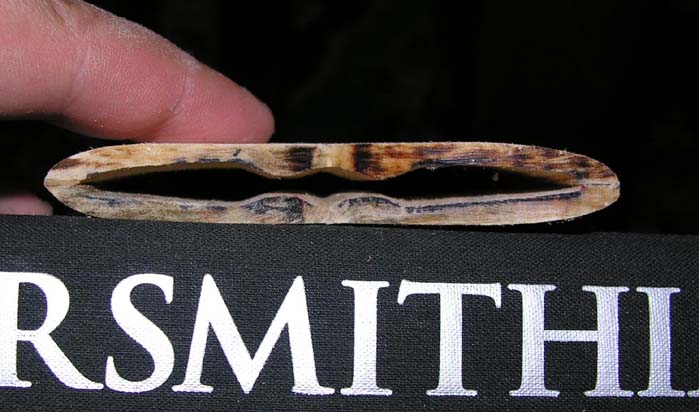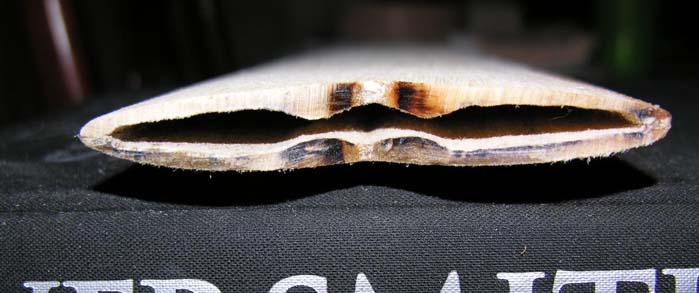Posts: 1,532 Location: Tennessee
Tue 14 Feb, 2006 6:01 pm
Thanks Addison.
I felt like it actually showed some promise. Lack of thought towards suspension is a major negative, but I have not even gotten a buckle or started thinking through the making of belt yet. I have no mail, plate or kit of any type to wear it with yet. It is primarily a storage and transport scabbard that I expect to prevent rust, and hold the sword securely if I take it anywhere.
There is no visible wood anywhere. What you may be looking at is wool felt (woven felt, not just crushed) that is dyed in "camel hair" color. This felt lines all of the scabbard interior (not sewn, just glued in as two halfs to minimize additional width/ space that a fully stiched socks did add in earlier trials), and is then turned down like a pant or sock cuff over the first 2" of the scabbard exterior. The idea to turn it down over the exterior was volunteered by another forum member when I described difficulties with the wool lining tending to pull loose if left flush with the mouth. With the downturned cuff method, the wool lining stays put. The guard of the sword seats on this wool felt. All wool is now seasoned with gun oil such that if you thoroughly wipe the blade dry with an absorbant paper towel and then insert it into the scabbard, it will have a very slight oil film on it when removed. Wool is a hollow fiber that if seasoned with oil when dry will tend to repel minor moisture from humidity or light fog and retain the oil. I am not willing to go as far as throwing the thing into a lake though......
I have a experimented for about 9 months now with another wool lined core and found that the blade of my Albion
Crecy blade never shows rust or patina upon removal from a "seasoned wool" lined scabbard regardless of how carelessly I put it away. In contrast, the Crecey's pommel tends to always have some rust and I have not been able to retard it even with cheap cold bluing treatments and a monthly oiling. I had some issues with the Crecey blade if it was stored in a bare wood core. It then needed regular oiling. I suspect blades typically get handled and touched less than pommels and guards though, because corrosion on the blade was never as big a problem as it has been on the pommel and guard.
A couple of wool lined trials for the Crecy and some unlined cores I had posted previously are shown below. These were all destroyed through load testing, I actually destroyed my last one (core number 9 or 10 would be my best guess) about 2 weeks ago at the point where I decided that 3/16" of wood is enough for just about anyones' standard of strength. You would fall down if anything hit it hard enough to break it while you were wearing it (true for laminated, not unlaminated.)
One more point. You may notice from the various openings that I had to really work with a partially fullered sword like the 1 st generation Crecey to get smooth entry withdrawl. If somebody formed fiberglass over it, they would discover what I stumbled into. The sword could not be withdrawn. This is because the thickest point along the centerline of the blade occurs where the fuller ends. Undoubtedly there are other blade geometries that are similar. The Knight sword was tremendously easy (full length fuller) to shape the core for, and I would expect full length diamond profiles (Albion Talhoffer, Ringeck, etc.) to be similarly easy to shape a core for.
 Attachment: 72.14 KB
Attachment: 72.14 KB
[ Download ]

